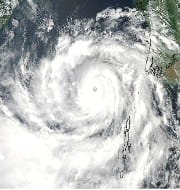RIMES terms Titli cyclone ‘rarest of rare’
Regional Integrated Multi-Hazard Early Warning System (RIMES) for Africa and Asia has termed ‘Titli’, the severe cyclonic storm that devastated Odisha in October 2018 as ‘rarest cyclone’. Earlier, India Meteorological Department (IMD) had called formation of Titli as ‘rarest of rare’ occurrence after this severe cyclone had changed its path after making landfall.
Key Facts
According to RIMES, Titli cyclone is rarest of rare in more than 200 years of cyclone track history in Odisha coast and also elsewhere. Its rare features were in terms of its characteristics such as recurvature after landfall, retaining its destructive potential after landfall and recurvature away from coastal areas for more than two days. Due to its rare features, forecast information lacked actionable early warning information such as no indication of occurrence of secondary hazards, including landslides far away from the coasts especially in interior districts of Odisha. Due to this, Odisha State Disaster Management Authority (OSDMA) had faced challenges in anticipating and managing Titli’s impact due to lack of impact-based actionable early warning information and prior experience. By learning lessons from Titli cyclone, measures can be evolved to minimise impacts in both coastal and non-coastal regions more effectively in future.
Suggestion
RIMES has recommended that detailed risk assessment has to be carried out for Odisha to understand the risks in light of the Titli devastation. At present, State government actions linked to cyclone-risk management are heavily focused on coastal areas where cyclones cross at their peak intensities. Therefore, coastal areas now have been largely well managed through evacuations and other protocols, leading to zero casualties in these areas.
Regional Integrated Multi-Hazard Early Warning System (RIMES)
It is intergovernmental body registered under United Nations. It is owned and managed by 45 collaborating countries in Asia Pacific and Africa Region. India is chairman of the body. It was established in 2009 and was registered with UN in July 2009. It operates from its regional early warning centre located at campus of Asian Institute of Technology in Pathumthani, Thailand. It has evolved from efforts of countries in Africa and Asia in aftermath of 2004 Indian Ocean tsunami.

Mandate
It seeks to establish regional early warning system within multi-hazard framework for generation and communication of early warning information and capacity building for preparedness and response to trans-boundary hazards. It provides information related to Tsunami and extreme weather conditions. It also acts as a test bed for emerging technologies and help to enhance performance.
Month: Current Affairs - November, 2018


